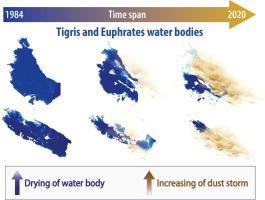Aeolian Research ( IF 3.1 ) Pub Date : 2021-04-06 , DOI: 10.1016/j.aeolia.2021.100698 Ali Darvishi Boloorani , Ramin Papi , Masoud Soleimani , Leyla Karami , Fatemeh Amiri , Najmeh Neysani Samany

|
The Tigris and Euphrates basin (TEB) has long been one of the active dust sources in the Middle East. In the last four decades, inefficient water resources management has intensified dust activities in the TEB. Dried water bodies have a high potential for dust emission. Therefore, several studies have been conducted in TEB to identifying dust sources. Nevertheless, the role of water body changes in dust emission is not yet clear. The present study aimed to evaluate the effect of natural and anthropogenic drivers on changes in water bodies and dust emissions. The long-term spatial-temporal monitoring of water bodies changes was performed using 36-year Landsat 5, 7, and 8 multi-spectral images. Using visual interpretation of MODIS-RGB143 images, 904 dust storm events were identified, about 61% of them originated from dried beds of lakes, marshlands, and river margins. The lowest area of water bodies was observed in the period from 2000 to 2004 and 2008 to 2012. The area of water bodies in the two mentioned periods has decreased by 31% and 33%, respectively. Severe droughts have occurred in the region during these two periods. Overall, this has led to an increase of almost 23% in dust activities. However, the relationship between change in the area of water bodies and dust emission in the TEB is not necessarily linear and straightforward. In general, it can be concluded that the dried beds of water bodies is the largest source of dust emission in the TEB.
中文翻译:

底格里斯河和幼发拉底河流域的水体变化影响了沙尘暴现象
底格里斯河和幼发拉底河盆地(TEB)长期以来一直是中东地区活跃的粉尘源之一。在过去的四十年中,低效率的水资源管理加剧了TEB中的粉尘活动。干水体具有很高的粉尘排放潜能。因此,已经在TEB中进行了一些研究来确定粉尘源。然而,水体变化在粉尘排放中的作用尚不清楚。本研究旨在评估自然和人为驱动因素对水体和粉尘排放变化的影响。使用36年的Landsat 5、7和8多光谱图像进行了水体变化的长期时空监测。使用MODIS-RGB 143的可视化解释图像中,发现了904起沙尘暴事件,其中约61%来自湖泊,沼泽地和河床边缘的干燥床。在2000年至2004年以及2008年至2012年期间,水体面积最低。上述两个时期的水体面积分别减少了31%和33%。在这两个时期,该地区发生了严重的干旱。总体而言,这导致粉尘活动增加了近23%。但是,TEB中水体面积的变化与粉尘排放之间的关系不一定是线性和直接的。通常,可以得出结论,水体的干燥床是TEB中最大的粉尘排放源。











































 京公网安备 11010802027423号
京公网安备 11010802027423号